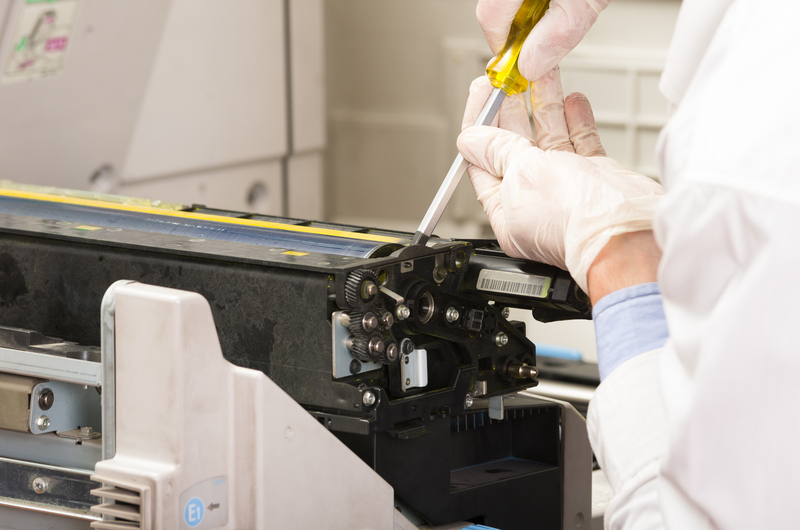Office Green Revolution: Reduce, Repurpose, Rethink Waste
With the rising importance of environmental sustainability in the corporate world, the office green revolution is taking center stage. Companies are realizing that reducing and managing office waste isn't just about compliance or corporate social responsibility--it helps foster innovation, efficiency, employee satisfaction, and brand reputation. In this comprehensive guide, we'll explore how your business can reduce, repurpose, and rethink waste in the workplace, embracing a sustainable future and earning the rewards that come with it.
Why the Office Green Revolution Matters
Office environments are surprisingly wasteful. From paper waste and electronics to plastic and food scraps, the average office generates a significant carbon footprint. According to the EPA, the average office worker generates nearly two pounds of paper waste each day. Multiply that by the number of employees, and the figures are staggering.
The transition to a greener, more sustainable office goes beyond environmental benefits. Reducing and rethinking office waste is tied to:
- Lower operational costs through reduced materials
- Enhanced employee engagement and morale
- Improved brand perception and stakeholder trust
- Better regulatory compliance and risk management
- Delivering on corporate social responsibility (CSR) promises

The Three Pillars of the Office Green Revolution
Let's break down the essential pillars--reduce, repurpose, and rethink--that form the heart of a successful office sustainability strategy.
1. Reduce
At its core, the office green revolution starts by minimizing waste creation. The mantra "less is more" applies perfectly here.
Practical Ways to Reduce Office Waste
- Implement Digital Workflows: Transition from paper-based processes to digital management systems. Encourage e-signatures and collaborative cloud tools like Google Workspace or Microsoft 365.
- Double-Sided Printing Policy: Set default printer settings to double-sided. This small change can cut paper consumption in half.
- Paperless Meetings: Use projectors, tablets, or laptops during meetings instead of printed agendas and handouts.
- Bulk Purchasing and Smart Supplies Management: Avoid over-ordering and opt for bulk packaging to cut down on excess packaging and shipping emissions.
- Encourage Reusable Office Supplies: Invest in reusable whiteboards, refillable pens, and durable kitchenware instead of disposables.
- Monitor and Audit Waste: Regularly review your office waste streams to find new opportunities for reduction.
Targeting Specific Office Waste Streams
- Paper: Move to cloud storage, foster a 'think before you print' policy, and recycle unavoidable paper waste.
- Plastics: Replace disposable cups and utensils with reusable alternatives.
- Food waste: Tip the balance by encouraging employees to bring their own reusable containers and donate unconsumed food.
- Electronics (E-Waste): Extend device life with regular maintenance, and responsibly recycle or donate old electronics.
2. Repurpose
Another crucial tenet of the office green revolution is to repurpose items destined for disposal. Rather than simply recycling, thoughtful repurposing can breathe new life into materials and equipment.
Creative Repurposing Strategies for Offices
- Upcycle Office Furniture: Instead of tossing out old chairs and desks, refurbish, repaint, or reassign them to different spaces.
- Reuse Single-Side Printed Paper: Convert to notepads or brainstorming sheets.
- Donate Unused Electronics: Partner with local nonprofits or schools that can use your surplus computers, monitors, and peripherals.
- Turn Packaging Into Storage Solutions: Reuse boxes for organization or as shipping materials for outgoing mail.
- Creative Art Projects: Engage employees in upcycling office waste into decorative or useful items to boost team spirit and environmental awareness.
- Swap Program: Start an inter-office exchange for gently used furniture or office supplies.
Benefits of Repurposing in the Workplace
Repurposing initiatives help reduce landfill waste, but they also foster a culture of resourcefulness and creativity. Teams that repurpose together often find innovative solutions to other business challenges, making sustainability good for organizational resilience.
3. Rethink
The final pillar requires a shift in mindset--rethinking every aspect of office operations, procurement, and culture through a green lens. It's about questioning old habits and embracing a circular economy approach.
Embedding Sustainability in Office Culture
- Green Procurement Policies: Prefer vendors and suppliers who adhere to sustainable practices and provide eco-friendly alternatives.
- Employee Green Teams: Form a cross-departmental group to spearhead green initiatives, track progress, and celebrate wins.
- Offer Incentives: Reward teams or individuals who champion sustainable actions or come up with creative waste reduction ideas.
- Continuous Education: Host workshops, lunch-and-learns, and webinars about reducing workplace waste and environmental sustainability.
Rethinking Office Layout and Design
- Modular Office Furniture: Invest in versatile, long-lasting furniture systems that can be reconfigured as needs change.
- Biophilic Design: Add indoor plants and green walls not only to enhance air quality but also to serve as living symbols of your sustainability mission.
- Dedicated Recycling and Composting Stations: Make recycling easy and visible, and educate employees on proper sorting and composting.
Office Green Revolution in Action: Real-World Examples
1. Google's Zero Waste to Landfill Initiative
Google's worldwide offices are excellent models of the office green revolution. Their Mountain View campus achieved a staggering 91% waste diversion from landfills by reducing packaging, prioritizing composting, and encouraging employees to rethink daily habits.
2. Interface's Net-Positive Approach
Carpet tile manufacturer Interface has gone beyond recycling to manufacture tiles from 100% post-consumer materials and even reclaim discarded fishing nets from oceans as supply for new products. Their sustainability drives innovation and positive publicity.
3. Local Small Businesses Making a Difference
It's not just global giants that can go green. Many small businesses repurpose old devices via community donations, encourage reusable coffee cups, and even set up mini-libraries for employees using repurposed materials.
How to Launch Your Own Office Green Revolution
Ready to join the movement and put reduce, repurpose, and rethink waste into practice? Here's a step-by-step blueprint:
Step 1: Analyze Your Current Situation
- Conduct a waste audit to understand what you're throwing away--and why.
- Gather feedback through surveys or suggestion boxes to involve employees.
Step 2: Set Green Goals and Metrics
- Set SMART (Specific, Measurable, Achievable, Relevant, Time-bound) targets, e.g., "Reduce paper waste by 50% in six months."
- Track energy, water, and material usage for a complete sustainability picture.
Step 3: Make Sustainable Changes Easy
- Place clearly marked recycling bins and instructions throughout the office.
- Switch to sustainable suppliers and products where possible.
- Provide the tools employees need (e.g., reusable office mugs, digital collaboration platforms).
Step 4: Communicate, Educate, and Motivate
- Regularly share progress and celebrate success stories.
- Educate about proper recycling and highlight the impact of each action taken.
- Challenge employees with friendly competitions (e.g., most creative upcycle project).
Step 5: Review and Improve
- Hold quarterly reviews to assess results and identify new opportunities.
- Invite fresh ideas. Sustainability is a journey, not a checkbox.
Common Roadblocks (And How to Overcome Them)
Change is challenging, and the journey toward a greener office isn't always smooth. Here are a few hurdles--and how to leap over them:
- Resistance to Change: Involve employees from the start, and tie green goals to personal and team incentives.
- Lack of Awareness: Educate through signage, guides, and green team ambassadors.
- Budget Constraints: Focus on quick wins first, like reducing paper, before moving to larger investments (such as solar panels or smart lighting).
- Vendor Limitations: Seek out local or alternative suppliers who share your green values.
Beyond Waste: Creating a Lasting Green Office Culture
Ultimately, the office green revolution means embedding sustainability into every decision--from procurement to project management, employee onboarding, and even company celebrations. By reducing, repurposing, and rethinking waste, you'll inspire a ripple effect that extends far beyond your four walls.
A green office isn't built in a day, but every step counts. Start today, and let your workplace be a beacon of environmental leadership in your community and industry.

FAQs About Greener Offices and Reducing Waste
- What is the most effective way to reduce waste in the office?
Start with paper: digitize documents, set printers to double-sided, and move to digital collaboration tools. - How can offices repurpose waste?
Refurbish furniture, donate unneeded electronics, repurpose packaging, and upcycle materials for creative use. - Why does rethinking office waste matter?
Rethinking enables long-term changes in purchasing, operations, and culture, unlocking innovation and resilience.
Take Action for an Office Green Revolution Today
Whether your office is just starting out or seeking the next level of sustainability, every action--big or small--contributes to a cleaner, greener future. By following the principles of reducing, repurposing, and rethinking waste, you join a growing revolution that redefines success for the modern workplace. Will your company lead the way?
Be the catalyst. Start your own office green revolution now!